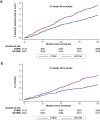Comparing the long-term outcomes in chronic coronary syndrome patients with prior ST-segment and non-ST-segment elevation myocardial infarction: findings from the TIGRIS registry
- PMID: 38110389
- PMCID: PMC10748995
- DOI: 10.1136/bmjopen-2022-070237
Comparing the long-term outcomes in chronic coronary syndrome patients with prior ST-segment and non-ST-segment elevation myocardial infarction: findings from the TIGRIS registry
Abstract
Objectives: Compared with ST-segment elevation myocardial infarction (STEMI) patients, non-STEMI (NSTEMI) patients have more comorbidities and extensive coronary artery disease. Contemporary comparative data on the long-term prognosis of stable post-myocardial infarction subtypes are needed.
Design: Long-Term rIsk, clinical manaGement and healthcare Resource utilisation of stable coronary artery dISease (TIGRIS) was a multinational, observational and longitudinal cohort study.
Setting: Patients were enrolled from 350 centres, with >95% coming from cardiology practices across 24 countries, from 19 June 2013 to 31 March 2017.
Participants: This study enrolled 8277 stable patients 1-3 years after myocardial infarction with ≥1 additional risk factor.
Outcome measures: Over a 2 year follow-up, cardiovascular events and deaths and self-reported health using the EuroQol 5-dimension questionnaire score were recorded. Relative risk of clinical events and health resource utilisation in STEMI and NSTEMI patients were compared using multivariable Poisson regression models, adjusting for prognostically relevant patient factors.
Results: Of 7752 patients with known myocardial infarction type, 46% had NSTEMI; NSTEMI patients were older with more comorbidities than STEMI patients. NSTEMI patients had significantly poorer self-reported health and lower prevalence of dual antiplatelet therapy at hospital discharge and at enrolment 1-3 years later. NSTEMI patients had a higher incidence of combined myocardial infarction, stroke and cardiovascular death (5.6% vs 3.9%, p<0.001) and higher all-cause mortality (4.2% vs 2.6%, p<0.001) compared with STEMI patients. Risks were attenuated after adjusting for other patient characteristics. Health resource utilisation was higher in NSTEMI patients, although STEMI patients had more cardiologist visits.
Conclusions: Post-NSTEMI chronic coronary syndrome patients had a less favourable risk factor profile, poorer self-reported health and more adverse cardiovascular events during long-term follow-up than individuals post STEMI. Efforts are needed to recognise the risks of stable patients after NSTEMI and optimise secondary prevention and care.
Trial registration number: NCT01866904.
Keywords: cardiac epidemiology; heart failure; myocardial infarction.
© Author(s) (or their employer(s)) 2023. Re-use permitted under CC BY-NC. No commercial re-use. See rights and permissions. Published by BMJ.
Conflict of interest statement
Competing interests: SP and RO have received research grant support from AstraZeneca. SGG has received speaker/consulting honoraria and/or research grant support from Amgen, Anthos Therapeutics, AstraZeneca, Bayer, Boehringer Ingelheim, Bristol‑Myers Squibb, CSL Behring, Daiichi Sankyo/American Regent, Eli Lilly, Esperion, Ferring Pharmaceuticals, HLS Therapeutics, JAMP Pharma, Merck, Novartis, Novo Nordisk A/C, Pendopharm/Pharmascience, Pfizer, Regeneron, Sanofi, Servier, Valeo Pharma and salary support/honoraria from the Heart and Stroke Foundation of Ontario/University of Toronto (Polo) Chair, Canadian Heart Research Centre and MD Primer, Canadian VIGOUR Centre, Cleveland Clinic Coordinating Centre for Clinical Research, Duke Clinical Research Institute, New York University Clinical Coordinating Centre, PERFUSE Research Institute, TIMI Study Group (Brigham Health). CBG has received consulting honoraria and/or research grant support from Armetheon, AstraZeneca, Bayer, Boehringer Ingelheim, Bristol-Myers Squibb, Daiichi Sankyo, Eli Lilly, Gilead, GlaxoSmithKline, Hoffmann-La Roche, Janssen, Medtronic, Pfizer, Salix Pharmaceuticals, Sanofi, Takeda and The Medicines Company. JCN has received speaker/consulting honoraria and/or research grant support from Amgen, AstraZeneca, Bayer, CSL Behringer, DalCor, Esperion, Janssen, Novartis, Novo Nordisk, Sanofi, Servier and Vifor. TS has received speaker/consulting honoraria and/or research grant support from Astellas, Amgen, AstraZeneca, Bayer, Boehringer Ingelheim, Eli Lilly, GlaxoSmithKline, Merck, Novartis, Pfizer and Sanofi. DW has received speaker/consulting honoraria and/or research grant support from AstraZeneca, Bayer, Berlin-Chemie, Biotronik and Novartis. SY has received speaker/consulting honoraria and/or research grant support from Takeda, Daiichi Sankyo, AstraZeneca and Boehringer Ingelheim. DB has received speaker/consulting honoraria and/or research grant support from Amgen, AstraZeneca, Bayer, Boehringer Ingelheim, BMS, Eli Lilly, Merck and Sanofi. MGC has received speaker/consulting honoraria and/or research grant support from AstraZeneca, Medtronic, Abiomed and Merit Medical. KA and PRH are employees of AstraZeneca. GB-W was an employee of AstraZeneca at the time of this study. SNK and PK declare no competing interests.
Figures


References
-
- Rogers WJ, Frederick PD, Stoehr E, et al. Trends in presenting characteristics and hospital mortality among patients with ST elevation and non-ST elevation myocardial infarction in the national registry of myocardial infarction from 1990 to 2006. Am Heart J 2008;156:1026–34. 10.1016/j.ahj.2008.07.030 - DOI - PubMed
-
- Pilgrim T, Vranckx P, Valgimigli M, et al. Risk and timing of recurrent ischemic events among patients with stable ischemic heart disease, non-ST-segment elevation acute coronary syndrome, and ST-segment elevation myocardial infarction. Am Heart J 2016;175:56–65. 10.1016/j.ahj.2016.01.021 - DOI - PubMed
Publication types
MeSH terms
Associated data
LinkOut - more resources
Full Text Sources
Medical
